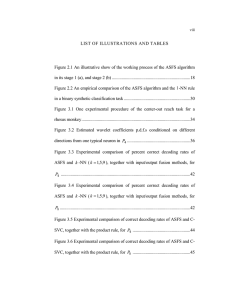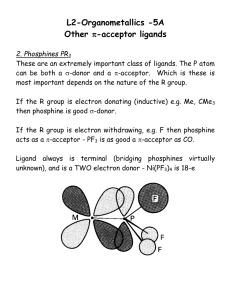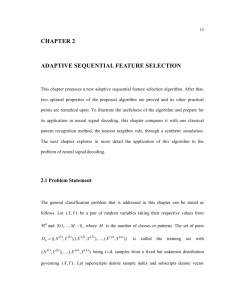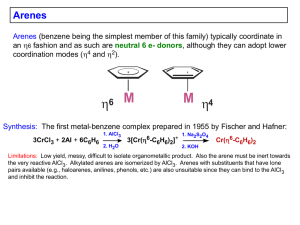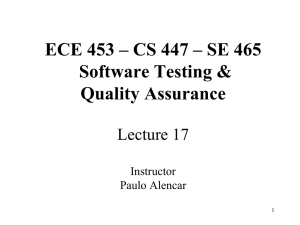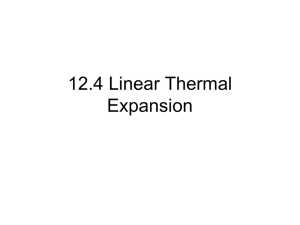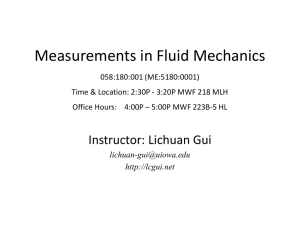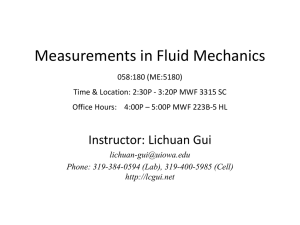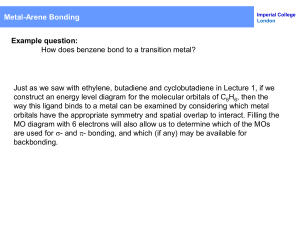Chapter 9 ( Cyclopentadienyl)
advertisement
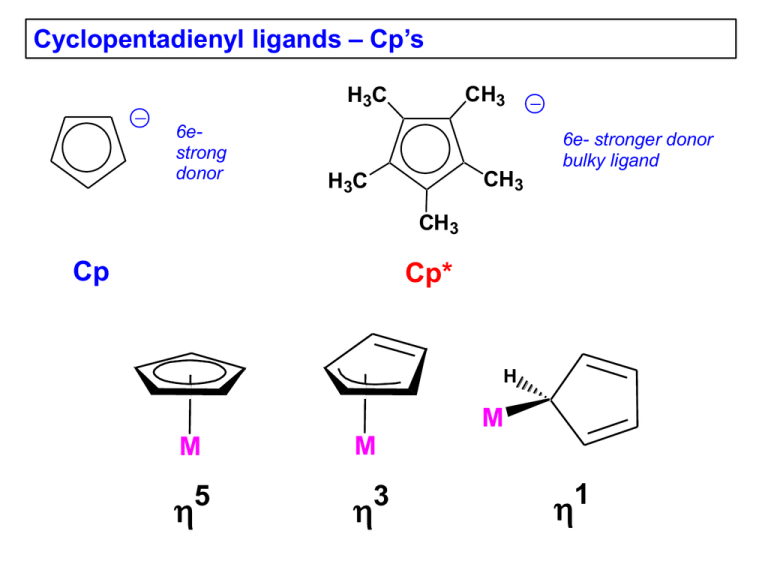
Cyclopentadienyl ligands – Cp’s CH3 H3C 6estrong donor 6e- stronger donor bulky ligand CH3 H3C CH3 Cp Cp* H M M 5 M 3 1 Free neutral cyclopentadiene, which is deprotonated with a strong base to generate the Cp-, is unstable and reacts with itself via a Diels-Alder reaction to make the dicyclopentadiene. One typically regenerates cyclopentadiene by distilling (“cracking”) it from the high boiling dimer solution and storing it in a refrigerator, but it slowly re-dimerizes to make dicyclopentadiene. + Brief History of Ferrocene: 1901 Synthesis of KC5H5 from K and C5H6 1951 Miller, Tebboth & Tremaine Sythesis of Fe(C5H5)2 from the reaction of C5H6 with freshly reduced Fe at 300ºC Kealy & Pauson 1951 3C5H5MgBr + FeCl3 → Cp2Fe + fulvalene + 3MgBrCl They were trying to make fulvalene! They proposed that they had made: Fe E. O. Fischer proposes a “Double-cone structure” 1952 X-ray structural data Diamagnetism Chemical behavior Geoffrey Wilkinson & Robert Woodward: “ Sandwich Structure” 1952 IR spectroscopy Diamagnetism Dipole moment = 0 Woodward noted that the Cp rings were susceptible towards electrophillic substitutions, similar to the aromatic behavior of benzene. Thus the common name: ferrocene 1973 Fischer & Wilkinson receive the Nobel Prize in Chemistry for their “discovery” of ferrocene, which played a key role in opening up the new area of organometallic chemistry. Some Properties of Metallocenes Complex Color “Ti(C5H5)2” green V(C5H5)2 purple 167 “Nb(C5H5)2” yellow - Cr(C5H5)2 scarlet 173 “Mo(C5H5)2” Black - “W(C5H5)2” yellow-green - Mn(C5H5)2 brown Fe(C5H5)2 orange mp/ºC Miscellaneous bimetallic with two m-H bridges and a fulvalene 200 (decomp.) bridging ligand (structure shown later) very air-sensitive, paramagnetic bimetallic with 1,5-C5H4 bridges and terminal hydrides (structure shown later). very air-sensitive several bimetallic isomers with fulvalene and 1,5 bridges and terminal hydrides (structures shown later), diamagnetic, airsensitive. same as Mo 173 air-sensitive and easily hydrolyzed, interesting high-spin to low-spin interconversion 173 air-stable, can be oxidized to blue-green [Fe(C5H5)2]+ which, in turn, is a good “inert” oxidizing agent. Co(C5H5)2 purple-black 174 air-sensitive, paramagnetic 19e- complex, can be oxidized to the air-stable 18e- yellow [Co(C5H5)2]+ Ni(C5H5)2 green 173 20e- complex, slow oxidation in air to the labile, orange cation [Ni(C5H5)2]+ Structural Features M-C C-C M Cp···Cp M M-C Cp…Cp C-C Fe 2.04 3.29 1.42 [Fe]+ 2.07 3.40 1.40 Ru 2.19 3.64 1.43 Os 2.19 3.61 1.45 Co 2.10 3.44 1.41 [Co]+ 2.03 3.24 1.42 Ni 2.18 3.63 1.41 The changes in the neutral Fe, Co, Ni metallocenes are a direct result of going from 18e- (Fe) to 19e- (Co) to 20e- (Ni) counts. The extra electrons for the Co and Ni complexes are going into M-Cp antibonding orbitals, which are delocalized and progressively weaken the M-Cp bonding, leading to the increase in bond distances. This in spite of the fact that the metal’s covalent radius is decreasing as one goes from Fe to Ni. Problem: Explain why the Fe-C distance lengthens for [Cp2Fe]+, while the Co-C distance shortens for [Cp2Co]+. Oxidation of Cp2Os does not produce a simple cationic monomer as seen for Co and Fe. Instead one gets dimerization to produce the following bimetallic complex that has an Os-Os bond (3.04 Å). Problem: Electron-count this complex. Is it para- or diamagnetic? Bis-Cp Early TM Complexes The simple neutral bis-Cp complexes of the early transition metals are quite different because they are in very low +2 oxidation states (very electron-rich) and quite unsaturated. Thus, they are very reactive towards C-H oxidative additions and other reactions. Me Ti Me Me H H Me CH2 Me Me Ti Ti Me Me Me Me Me Me Me Ti H Me Me Me Me Me Problem: Electron-count this Ti2 complex. Is it paraor diamagnetic? H Nb H Nb Me Mo-Mo = 3.19Å Mo Mo THF H 50°C H2O H Mo 100°C Mo H h H Mo H Mo toluene 70°C Mo-Mo = 3.36Å Cp Variants these have special bonding properties important in substitution reactions (see that chapter) 2- fulvalenediyl (2-) indenyl (-) fluorenyl (-) Mo 2.45Å azulene Behrens, Angew. Chem., 1987 6edonor MO Comparison of Cp- vs. Arene Ligands Benzene-Metal Complex Cyclopentadienyl-Metal Complex metal d orbitals metal d orbitals M M
